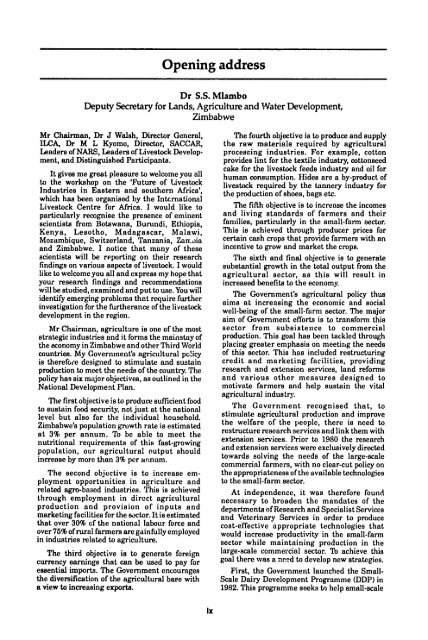aistand south~ern afrkca - (PDF, 101 mb) - USAID
aistand south~ern afrkca - (PDF, 101 mb) - USAID
aistand south~ern afrkca - (PDF, 101 mb) - USAID
You also want an ePaper? Increase the reach of your titles
YUMPU automatically turns print PDFs into web optimized ePapers that Google loves.
Opening address<br />
Dr S.S. Mla<strong>mb</strong>o<br />
Deputy Secretary for Lands, Agriculture and Water Development,<br />
Zi<strong>mb</strong>abwe<br />
Mr Chairman, Dr J Walsh, Director General,<br />
ILCA, Dr M L Kyomo, Director, SACCAR,<br />
Leaders ofNARS, Leaders of Livestock Development,<br />
and Distinguished Participants.<br />
It gives me great pleasure to welcome you all<br />
to the workshop on the 'Future of Livestock<br />
Industries in Eastern and southern Africa',<br />
which has been organised by the International<br />
Livestock Centre for Africa. I would like to<br />
particularly recognise the presence of eminent<br />
scientists from Botswana, Burundi, Ethiopia,<br />
Kenya, Lesotho, Madagascar, Malawi,<br />
Moza<strong>mb</strong>ique, Switzerland, Tanzania, Zarr-uia<br />
and Zi<strong>mb</strong>abwe. I notice that many of these<br />
scientists will be reporting on their research<br />
findings on various aspects of livestock. I would<br />
like to welcome you all and express my hope that<br />
your research findings and recommendations<br />
will be studied, examined and put to use. You will<br />
identify emerging problems that require further<br />
investigation for the furtherance ofthe livestock<br />
development in the region.<br />
Mr Chairman, agriculture is one of the most<br />
strategic industries and it forms the mainstay of<br />
the economy in Zi<strong>mb</strong>abwe and other Third World<br />
countries. My Government's agricultural policy<br />
is therefoe designed to stimulate and sustain<br />
production to meet the needs of the country. The<br />
policy has six major objectives, as outlined in the<br />
National Development Plan.<br />
The first objective is to produce sufficient food<br />
to sustain food security, not just at the national<br />
level but also for the individual household,<br />
Zi<strong>mb</strong>abwe's population growth rate is estimated<br />
at 3% per annum. To be able to meet the<br />
nutritional requirements of this fast-growing<br />
population, our agricultural output should<br />
increase by more than 3% per annum<br />
The second objective is to increase employment<br />
opportunities in agriculture and<br />
related agro-based industries. This is achieved<br />
through employment in direct agricultural<br />
production and provision of inputs and<br />
marketing facilities for the sector. It is estimated<br />
that over 30% of the national labour force and<br />
over 75%of rural farmers are gainfully employed<br />
in industries related to agriculture,<br />
The third objective is to generate foreign<br />
currency earnings that can be used to pay for<br />
essential imports. The Government encourages<br />
the diversification of the agricultural base with<br />
a view to increasing exports.<br />
Ix<br />
The fourth objective is to produce and supply<br />
the raw materials required by agricultural<br />
processing industries. For example, cotton<br />
provides lint for the textile industry, cottonseed<br />
cake for the livestock feeds industry and oil for<br />
human consumption. Hides are a by-product of<br />
livestock required by the tannery industry for<br />
the production of shoes, bags etc.<br />
The fifth objective is to increase the incomes<br />
and living standards of farmers and their<br />
families, particularly in the small-farm sector.<br />
This is achieved through producer prices for<br />
certain cash crops that provide farmers with an<br />
incentive to grow and market the crops.<br />
The sixth and final objective is to generate<br />
substantial growth in the total output from the<br />
agricultural sector, as this will result in<br />
increased benefits to the economy.<br />
The Government's agricultural policy thus<br />
aims at increasing the economic and social<br />
well-being of the small-farm sector. The major<br />
aim of Government efforts is to transfbrm this<br />
sector from subsistence to commercial<br />
production. This goal has been tackled through<br />
placing greater emphasis on meeting the needs<br />
of this sector. This has included restructuring<br />
credit and marketing facilities, providing<br />
research and extension services, land reforms<br />
and various other measures designed to<br />
motivate farmers and help sustain the vital<br />
agricultural industry<br />
The Government recognised that, to<br />
stimulate agricultural production and improve<br />
the welfare of the people, there is need to<br />
restructure research services and link them with<br />
extension services. Prior to 1980 the research<br />
and extension services were exclusively directed<br />
towards solving the needs of the large-scale<br />
commercial farmers, with no clear-cut policy on<br />
the appropriateness ofthe availabletechnologies<br />
to the small-farm sector.<br />
At independence, it was therefore found<br />
necessary to broaden the mandates of the<br />
departments ofResearch and Specialist Services<br />
and Veterinary Services in order to produce<br />
cost-effective appropriate technologies that<br />
would increase productivity in the small-farm<br />
sector while maintaining production in the<br />
large-scale commercial sector. 'b achieve this<br />
goal there was a need to develop new strategies.<br />
First, the Government launched the Small-<br />
Scale Dairy Development Programme (DDP) in<br />
1982. This programme seeks to help small-scale

















